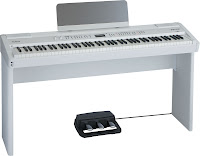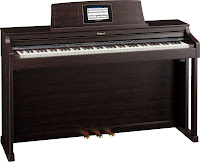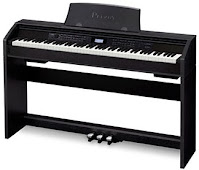UPDATED REVIEW – February 1, 2014 – The Roland FP7F is discontinued and has been replaced by an upgraded and improved model called the FP80. The HPi7F is discontinued and replaced by the HPi50. See my new HPi50 review at the following link: Roland HPi50 Review
Below is my original review of the Roland FP7F along with the HPi7F & HPi6F. *Please note that it is likely the regular discount prices on any remaining discontinued models has probably gone down so you can likely save some money. However, the new models are substantially better in some ways and may not be much more money than the older models.
Original review from 2010. In the last year or so, Roland introduced brand new features in other model pianos including their “SuperNATURAL” piano tone, top of the line PHAIII Ivory feel keyboard action with escapement, bigger and better user interface screens, additional cabinet finishes, vocal harmony singing controls for Karaoke type music, and a few other cool features. Roland is well known for its pro electronic keyboard, guitar, drum, and computer music gear including their BOSS and Edirol divisions. So when they create and design a new control, sound, special effect, keyboard action, user interface screens, connection, or other cool things, they can take those items and integrate them into their other products, which is a very cost effective and efficient thing to do. Not surprisingly, Roland went ahead and put some of these new features in these 3 pianos. For this new series, the previous generation FP7, HPi6, and HPi7 now all have the SuperNATURAL piano tone and ivory feel keyboards. These pianos also have the upgraded PHAIII with 100 levels of touch sensitivity keyboard action for greater sonic control and refinement over playing styles and dynamics (except for the HPi6F which has the older PHAII key action with 5 levels of touch sensitivity).
The FP7F (above & at left in white with stand & pedals) is suited for all kinds of applications including home, stage, church, professional, and personal recording and arranging. Great tones, piano feel, features, easy to use controls with good LCD user interface, 128-note polyphony, and very portable with a built-in 24 watt stereo speaker system. One of the direct competitors to the FP7F is the new Kawai MP6 portable piano. In my opinion the new Kawai has a more authentic piano touch and tone and gives the player more flexibility when it comes to sounds and ease of use. You can check out the Kawai MP6 in my blog review at https://azpianonews.blogspot.com/2011/01/kawai-mp6-digital-piano-awesome-piano.html
The HPi6F & HPi7F are home pianos geared toward music education for students. There is an extensive list of features for all 3 of these pianos, way too many for me to go through here. But I can assure you that all 3 instruments are very nice and will do a great job for what they were designed to do. And they look good too:) I believe these Roland pianos are great sounding, playing, and very well designed pianos available today for their respective price ranges and for what they do. However, they are not inexpensive.
The new FP7F with piano stand (but not including 3-pedal system) sells at a discount for $2299US. The new HPi6F full cabinet home piano model is selling at a discount price approx of $4499US (pictured below) in stores and the top model HPi7F is selling at a discount price of approx $5999US in Roland piano stores. So to put it simply…these pianos not inexpensive but they are very high quality and have very cool features including their interactive display screens and educational software. Also, the vocal harmony feature in these models lets you sing through a mic and have your solo voice automatically harmonized by reproducing your voice in multiple parts using the harmony feature as you play the piano. It really is fun, assuming you like to sing:)
Although I do like the new FP7F portable stage & home piano and it’s price range is at least somewhat affordable so I recommend it. The other 2 models are quite a bit more money and have large color display monitor screens and the built-in educational software programs as compared to their regular HP series pianos. I have used these interactive software programs for both kids & adults and they are easy to use, fun, and amazing and helps a great deal with music education. So it just depends on how you want to approach it. The HPi6F & HPi7F are certainly enjoyable to play, have excellent piano tone and touch with lots of additional instrument sounds, and are helpful for music education with their fun and intuitive learning & notation on the built-in monitor.
In the lower price range there are other very good, less expensive ways of learning to play the piano while sounding great such as what Casio is currently offering with their Privia PX780 piano for $999 discount internet price (pictured left). I have played this model extensively and the piano has a very good piano key action for smooth control over dynamics, an upright piano tone reproduction with 40 watts of power using 4 speakers, and ivory feel keys (unusual in this lower price range) along with hundred of other useful piano education features for beginning through advanced students and players. It has a built-in CoreMIDI USB port with automatic plug & play drivers which would automatically connects to a laptop or iPad. I have reviewed the PX780 piano on this blog if you do a search in my blog search bar on the right side. But in the higher price range, the Roland HPi series is unique for what it offers and can be a great choice for a family seeking an “all-in-one” solution giving you a great sounding and playing piano with enough fun and interactive educational features to stimulate your musical desires and allow you to musically express yourself in a variety of ways. I do recommend the Roland HPi6F, HPi7F, and FP7F.
If you want more info on these and other pianos and lower prices than internet discounts, please email me at tim@azpianowholesale.com or call me direct at 602-571-1864


















i'm 70 years old now…and finally i've found a great keyboard for classical music….congratulations roland
Chúng tôi muốn nhận đuợc sự so sánh toàn diện giữa HPi7F và HP 307
Chúng tôi cung hy vọng hãng roland đặt đại lý và trung tâm bảo hành ở việt nam
HPi7F về cơ bản là piano giống như HP307 inpiano phím, giai điệu, cảm ứng, và âm thanh, ngoại trừ việc nó cũng có các tính năng giáo dục bổ sung và màn hình hiển thị lớn cho các bài học và đọc âm nhạc.
Hi, I am considering buying a Roland hpi-7f digital piano, but I am concerned that it might be akin to buying a luxury car in order to have a GPS, now that I see you mention the ability to plug in a laptop to a less-expensive model. I just want a piano that feels and sounds like a piano, without having to be tuned, and I like the idea of having headphones on it, and the educational software for my children. I have a degree in piano performance, so I want something that feels and sounds really nice and am leaning towards a Roland for its supernatural touch technology. I have found a hpi-7f online for 4800. What do you recommend? Do you think I could get a better deal with a different model and just using software with my laptop? And if so, what software? I also worry about finding digital sheet music for the digiscore system.
I bought the Roland HPi-7f almost a year ago and it is awesome. Sounds great and yes, the screen might be a bit of a luxury, but it is so much better having it all there without having to muck around with the extra laptop/ipad. Selecting tones and rhythms and songs and recording is so much easier as well being able to do in on the big screen (compared to the HP307/305 (which I also considered getting). So depends if you think the extra hassle is worth the savings in the long run. I think you get more built in rhythms with this too. A few things though which may or not be such a big deal: the screen cannot be turned off/dimmed if you don't need it while playing. The keys can be a bit 'thuddy' when playing and you can hear them when the volume is down low or if you have headphones in then others can hear the keys as you press them. Maybe all digitals are like that though. I did play a few before buying but only really noticed it after I bought it. Not too big of a deal for me though. I also notice when playing piano with strings tones, the strings can just cut out at times but maybe that's just my technique or the polyphony reaching its max. It still plays nicely and I'm very happy with it. Like most people will say though, play on floor models before buying to see how you like it.
Roland has a noticeably louder key action than other brands when it comes to what you mentioned. As far as the strings cutting out, that is all about polyphony which effects sound, pedal sustain, and combining automatic accompaniment features with the instrument sounds etc. The polyphony has maxed out. 128 polyphony is now considered old and antiquated in higher priced new model pianos. 192-256 is now becoming standard. Even Casio is just about to come out in October or November with a 256 note polyphony piano with ivory feel graduated hammer action priced at $1100. Combined with an iPad, that would be a very exciting combination in my opinion.
Ok that's good to know about the Roland louder key action. When choosing a piano at this price range I also looked into the Yamaha CVP501/503 and the Kawai CP119. All these have 128 note polyphony and are already starting to get pretty pricey. The Kawai CP139 was the next step up at 192 notes. All have been out for a few years now but still on their websites as mid to higher end models. Haven't done much research on the newer stuff so definitley check out Tim's suggestions. Anyway, polyphony is only one aspect of things. There are other things which you might place more importance on. I'm not that awesome on the piano so 128 is enough for what I do if I'm just playing piano and no strings. On a side note, I spent many hours on forums reading reviews including this site so thanks Tim for your thoughts and advice. It really helped.
Best action of any digital piano I've tried so far. Just like playing a grand!
The Roland hpi 7f is 2 years old now, do you still recommend? I have an iPad so do I really need the screen (does it have better functionality than connecting iPad)? What would you recommend as an alternative without the screen that can hook up to iPad? Happy to spend up to $4000, but if there's a great piano with all the bells and whistles for cheaper than great!
Thanksg